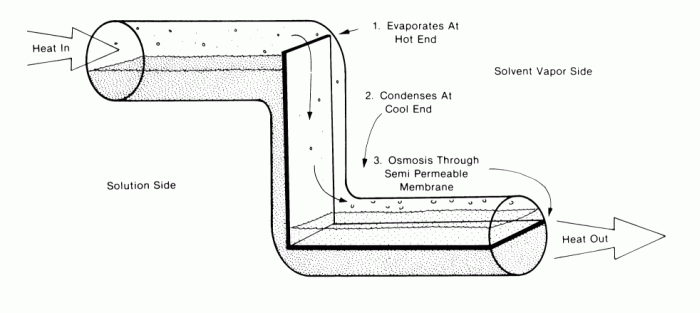A heat pipe for long-distance downward heat
transfer
(The text and drawing below are from Steve Baer's book, Sunspots, an
exploration
of solar energy through fact and fiction, 1979, Cloudburst Press,
ISBN 0-88930-061-5, p. 30. Excerpt published here by permission of
Steve
Baer.)
Start of excerpt:
A New Kind of Heat Pipe
Heat pipes conduct heat by using the evaporation and condensation of a
liquid inside a closed tube. Normally such a cycle can only work if the
heat is introduced at a lower level than where it is taken out. The low
liquid boils; the vapor rushes to the cold end where it condenses; and
the liquid condensate drips back to boil once more. The heat pipe
ignores
this requirement of gravity by using a wick. Even if the heat is
applied
at the top end of a heat pipe the cycle of evaporation and condensation
will continue. The wick within the tube pumps the cold condensate back
up to the hot end to be boiled away again cycle after cycle. If the
wick
were not there, the top end of the pipe would stay hot and the cold end
cold, and there would be no evaporation or condensation and thus very
little
heat transport. (Conduction down the tube would continue at its
relatively
slow rate, as would radiant transfer within the tube.) The heat pipe is
a wonderful invention, but it has great limitations. Wicks cannot lift
the liquids more than a few inches. We can never put the heat in very
much
higher than where we take it out.
One day while looking at a diagram of a semipermeable membrane in
Enrico
Fermi's Thermodynamics I realized that heat pipes could be built with
enormous
differences in elevation using a semipermeable membrane to return the
liquid
from the low cold end to the high hot end.

Impurities--such as a salt--must be added to the solution so that
there
will exist a concentration gradient across the membrane. The pure
distilled
condensate collecting at the low end will then be driven through the
semipermeable
membrane to re-enter the solution.
Although I obtained a patent on this heat transport device (United
States
Patent No. 3,561,525), I am ashamed to say I never once tried out the
idea.
End of excerpt.
Click here to see US patent
3,561,525. (PDF, 250KB)
Note unrelated to heat pipes: Steve Baer's company, Zomeworks,
specializes in passive solar energy products. See Zomeworks Double Play
Systems for passive heating and cooling of buildings: http://www.zomeworks.com/tech/doubleplay/index.html.
The principles of Double Play Systems should, for the first time, make
thermal components needed for 100% passive solar houses profitable for
manufacturers, and perhaps create an entirely new market.
Home

